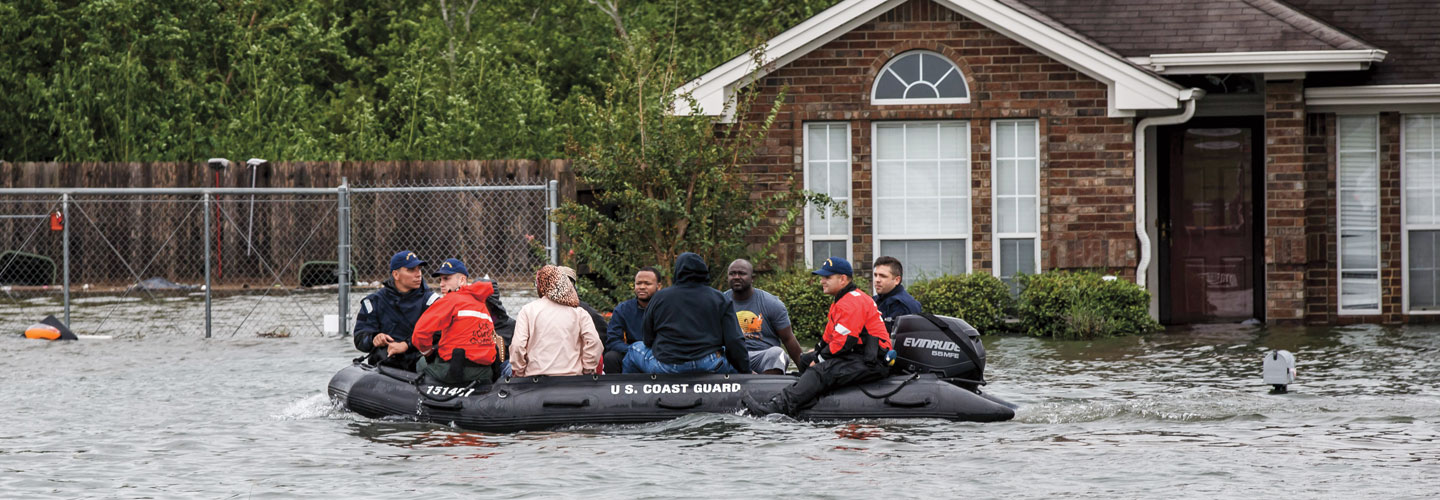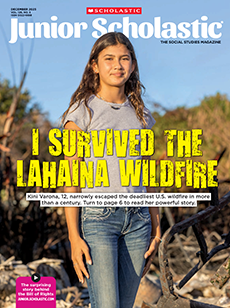
The Coast Guard picks up stranded residents of Port Arthur, Texas, on August 30.
The Future of Storms?
Are powerful hurricanes like Harvey and Irma a sign that climate change is beginning to affect our weather?
Early on the morning of August 27, as Hurricane Harvey pummeled Texas, floodwaters began lapping at the Nguyen family’s tree-lined front yard in Houston. Within hours, water rushed into their two-story brick house. The dad, Viet, plunged through the currents to grab life jackets and a raft from the garage.
“Are we going to die?” asked Brayden, 9.
The Nguyens survived, but Harvey destroyed most of their belongings and did major damage to their home. It was one of the worst natural disasters in U.S. history. As the hurricane turned city streets into raging rivers, tens of thousands of people had to flee their homes. Thousands of others were left stranded, some waiting desperately on rooftops for rescue by boat or helicopter. At least 70 people died.
Residents of Vilano Beach, Florida, examine a home toppled by Hurricane Irma on September 12.
Less than two weeks after Harvey, Hurricane Irma—one of the strongest Atlantic storms ever recorded—struck. Irma flattened islands in the Caribbean, then slammed into Florida. Millions of people were forced to evacuate. More than 50 people were killed by the storm.
What made these hurricanes so intense? Scientists are now trying to figure that out, including what role, if any,
“People always want to know, is it climate change or is it not?” says Katharine Hayhoe, a climate scientist at Texas Tech University. “The answer is, it’s in between.”
While climate change didn’t necessarily cause Harvey or Irma, many scientists say it likely deepened the storms’ impact, making an already bad situation worse.
How Hurricanes Form
Hurricanes are some of the most destructive storms on Earth. Their strong winds and heavy rainfall often tear apart buildings, roads, and other structures in their path. Hurricanes can also push rising seawater inland, flooding entire neighborhoods.
The storms form over warm ocean waters, drawing their power from hot, moist air evaporating upward. Over the past century, Earth and its oceans have gotten warmer, creating more opportunities for tropical storms and hurricanes like Harvey and Irma.
27 Trillion: Gallons of rain that fell in Texas and Louisiana over six days during Hurricane Harvey
Why is the planet getting warmer? Most scientists say that it’s because of a rise in greenhouse gases. Some of those gases occur naturally; others are produced by human actions. For example, the burning of
Greenhouse gases let sunlight through but also act like a greenhouse, trapping heat in the atmosphere. The higher the concentration of greenhouse gases, the warmer the planet gets. In the past century alone, Earth’s average annual temperature has risen about 1.5 degrees Fahrenheit (see graph, below). And for three years straight, the planet has broken records for highest global average surface temperature, according to NASA.
Not Typical Storms
Harvey didn’t behave like hurricanes usually do, experts say, because it continued to gain momentum even as it neared shore. Harvey also stayed intact for several days on land, and its punishing 115-mile-per-hour winds and rain were concentrated in the same area. Storms usually move steadily inland or back out to sea, so their damage is spread out.
Some scientists say Harvey’s last-minute power surge and its onshore duration can be tied to water temperature. The Gulf of Mexico, where Harvey formed, was already warmer than usual due, in part, to searing summer air temperatures. That heat transformed Harvey from a thunderstorm with strong winds into a major hurricane in roughly 48 hours, a day or two faster than is typical.
6.3 Million: People in Florida asked to evacuate before Hurricane Irma
Irma formed in the Atlantic Ocean off Africa’s coast. There too, the water was warmer than average and the storm grew to massive proportions—reaching 425 miles across—as it moved west. The heat helped the hurricane’s winds swirl more than 185 miles per hour for a record 37 hours straight.
In Harvey’s case, climate change likely contributed to the storm’s record-breaking rainfall, scientists say. Warmer air holds more water, so mega storms tend to dump more rain as global temperatures rise. Houston got nearly 52 inches of rain in five days—more than the city usually gets in a year.
“Harvey was not caused by climate change,” scientist Stefan Rahmstorf told The Washington Post. “Yet its impacts—especially the extreme rainfall—very likely worsened due to human-caused global warming.”
A Disaster Waiting to Happen
Not all scientists are ready to point the finger at climate change, though. Some say both Harvey’s and Irma’s devastation, coming during the peak of hurricane season, would have happened regardless.
Miami, Florida, for example, is low-lying and one of the country’s most vulnerable spots for hurricanes. In addition, South Florida’s infrastructure isn’t fully equipped to deal with recent construction and population growth. More than 6 million people have moved to the state since 1990.
“There is a constant battle between our ability to prepare for hurricanes and the pressure for urban expansion,” says Jean-Pierre Bardet, an engineering professor at the University of Miami.
Houston, too, is at high risk for hurricanes, scientists say. The low-lying coastal city is on the Gulf of Mexico, one of the most common spots for hurricanes to form. The city has struggled with flooding on and off for more than a century.
As Houston grew rapidly over the past two decades, flooding only got worse. Some developers built entire neighborhoods next to or even inside floodplains—the areas most likely to end up underwater.
As the city expanded, it also added about 25 percent more pavement, cutting back on prairies and wetlands around the city. Unlike soil, roads and parking lots do not absorb water, making the effects of excess rainfall even worse.
Those conditions made an event like Harvey almost inevitable, say Suzana Camargo and Adam Sobel, science professors at Columbia University.
“Given a metro area of 6.5 million people that basically sits in a paved floodplain, crossed by bayous, creeks, and rivers, and the same [weather] situation, we would be seeing a very major disaster even without any human influence on climate,” the professors wrote in Fortune magazine.
A woman and her baby are rescued by a Houston police officer on August 27.
More Storms Ahead?
At the same time that Harvey and Irma were wreaking havoc in the United States, extreme weather was ravaging South Asia. Flooding killed more than 1,000 people and displaced millions in India, Nepal, and Bangladesh this past summer. Mumbai, India, got as much rain in 12 hours on one August day as it usually gets over 11 days in a typical monsoon. Britain, Ireland, and parts of Africa also suffered from heavy floods.
Scientists worry that such extreme storms are a warning sign of what’s to come. Data shows that rising air and water temperatures could make powerful storms like Harvey and Irma more frequent. That idea scares people who live in hurricane-prone regions.
$190 Billion: Estimated cost of the damage caused by Hurricane Harvey
“If this isn’t climate change, I don’t know what is,” Miami Mayor Tomás Regalado told the Miami Herald as his city prepared for Irma. “This is . . . truly, truly [a] poster child for what is to come.”
Record rainfalls like Harvey’s may also become more common, making freshwater flooding a bigger threat, experts say. A recent federal report by more than 300 experts stated that rains have become heavier and more frequent, with the amount of precipitation on the wettest days also increasing. The study warns that the driving force behind the changes is hotter air from “human-caused warming.”
As scientists search for answers, the Nguyen family has started the long process of rebuilding their Houston home—and their lives.
“This has been traumatic,” Viet Nguyen says. “But I try to be practical about it and remember what we still have.”
With reporting by The New York Times
CORE QUESTION: How might the impacts of Harvey and Irma affect the way coastal cities prepare for hurricanes in the future?
How You Can Help
It can be tempting to send food, clothing, or other goods after a natural disaster. But experts say such items often go to waste. Instead, consider giving money—even $5—to a worthy group. Below are three charities helping people affected by the recent hurricanes. Visit charitynavigator.org to find more.
American Red Cross: redcross.org
Save the Children: savethechildren.org
United Way: unitedway.org/recovery
It can be tempting to send food, clothing, or other goods after a natural disaster. But experts say such items often go to waste. Instead, consider giving money—even $5—to a worthy group. Below are three charities helping people affected by the recent hurricanes. Visit charitynavigator.org to find more.
American Red Cross: redcross.org
Save the Children: savethechildren.org
United Way: unitedway.org/recovery
